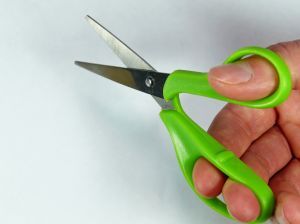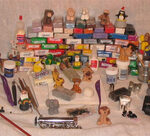A fundamental part of the preschool art area is using scissors. Before being set loose with scissors, children need to learn how to use them appropriately. Use this guide to preschool cutting to help young children safely and successfully use them.
Preparation of the Hand
Using scissors requires the use of several muscles in the hands and fingers. To develop strength, the child needs to exercise those muscles. Start by letting him knead play-doh or modeling clay. Engage him in other fine motor activities such as stringing beads, and transferring beads and pompoms with fingers, tongs, and tweezers. There are even tongs that resemble scissors that can give the child extra practice. He can also practice holding paper properly and work the finger muscles by tearing strips of paper.
Proper Cutting Technique
Show the child how to properly hold the scissors in the dominant hand. Deliberately exaggerate placing the thumb in the small hole and two fingers in the large hole. Then open and close your hand to demonstrate how the scissors open and close.
Choose a piece of paper for cutting. Initially use a thin strip of blank paper that can easily be cut with just one snip. Hold it in the sub-dominant hand while cutting with the dominant hand. Model keeping both hands facing forward.
Paper Cutting Strips
When the child has had some practice cutting a narrow strip of paper, she can then move to cutting narrow strips on lines. After narrow paper, use wider strips that require the hand to open and close more than once. Start with straight lines across the strip. Next, use diagonals, followed by zig zags. Curved lines are next in the sequence, as they are more difficult, requiring hands to turn while cutting.
Make your own cutting strips, or download strips for free from Montessori Materials. Photocopy each piece of paper on a different color, to distinguish between the levels of difficulty. To prepare the strips for the children, cut off the borders. Next, cut along the dotted lines to make strips smaller. Finally, cut along the long solid lines to make them into strips.
Further Cutting Practice
When children have mastered cutting these strips and lines, they are ready to practice the same lines on larger pieces of paper. They can also try to cut spirals on lines. Fold paper in half and draw half a shape, such as half a butterfly. Show them how to make snowflakes. Let them cut out pictures from magazines. Allow for free exploration and expression in artistic creations.
Types of Scissors to Use
Fiskars scissors are the best brand to purchase, though some off brands are relatively okay. Beware of types of scissors that claim to not cut hair. They really do not cut hair; however, they also do not cut paper very well. You also no longer have to worry about purchasing separate scissors for left-handed children to use. Modern scissors are equipped to be used with either hand.
For children who are having difficulty mastering the grip on the scissors, consider using teacher-assisted scissors. These have four finger holes. The child’s fingers go in the inner set, and the teacher’s fingers go in the outer holes, so that the teacher is guiding the cutting. There are also scissors that have no finger holes, but a flexible plastic band that connects the two blades. They require more of a full-hand open-close motion.
After children are adept at using regular scissors, they will also enjoy trying to use scrapbooking edgers for more creativity.
Scissor Safety
Teach children to be safe when using scissors. Never point them at another person. When handing them to another person, offer them with the handle side out. When walking across the room, always hold them with two hands, point down. Consider having children carry scissors in a small jar. Only paper is appropriate for cutting.
Repeat any steps in this guide to preschool cutting activities as necessary. Move at the child’s pace to ensure success. Encourage free exploration and creativity, while also maintaining safety.







